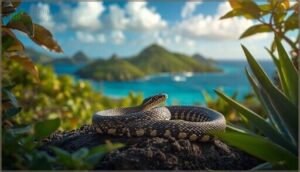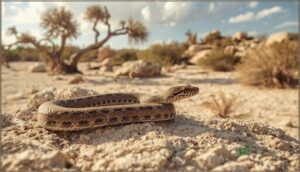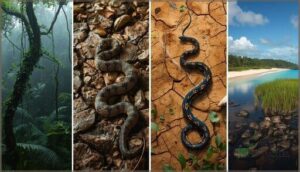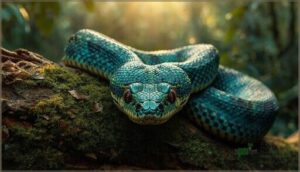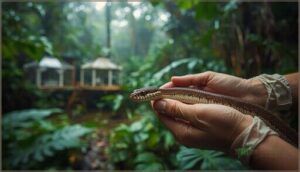This site is supported by our readers. We may earn a commission, at no cost to you, if you purchase through links.
The Saint Lucia Racer clings to survival with fewer than 20 individuals left on Earth—making it rarer than the giant panda or Sumatran rhino. While conservation headlines celebrate charismatic mammals, dozens of snake species vanish quietly from remote islands, forgotten forests, and fragmented habitats across the globe.
You won’t find these serpents in field guides or nature documentaries, yet their disappearance signals collapsing ecosystems that sustain countless other species.
From the Antiguan Racer’s striking comeback to Orlov’s Viper’s precarious foothold in the Caucasus Mountains, rare snake species face threats that range from invasive predators to habitat destruction. Understanding which snakes teeter on extinction’s edge—and why—reveals both the fragility of our natural world and the conservation strategies that actually work.
Table Of Contents
- Key Takeaways
- World’s Rarest Snake Species
- Critically Endangered Snakes by Habitat
- Unique Characteristics of Rare Snakes
- Major Threats to Rare Snake Populations
- Conservation Efforts and Species Recovery
- Frequently Asked Questions (FAQs)
- What is the no. 1 deadliest snake in the world?
- What is the most unique snake?
- How do rare snakes reproduce and breed?
- What do rare snakes typically eat?
- How long do rare snakes live?
- Where can you legally see rare snakes?
- How are new rare snake species discovered?
- How long do rare snakes typically live?
- What do endangered snake species primarily eat?
- Can rare snakes be kept as pets legally?
- Conclusion
Key Takeaways
- Fewer than 20 Saint Lucia Racers survive on a nine-hectare islet, making them rarer than giant pandas, while the Antiguan Racer rebounded from 50 individuals in 1995 to nearly 900 today through mongoose eradication and habitat restoration—proving targeted conservation actually works.
- Island-isolated snakes face existential threats from invasive predators like mongooses and brown tree snakes, which have decimated endemic populations, while habitat fragmentation traps species like Orlov’s Viper in patches smaller than 100 square kilometers.
- Over 85% of critical snake habitats have vanished in regions like California’s Central Valley, and climate change could eliminate 70% of some species’ ranges by 2070, compounded by illegal wildlife trafficking moving over 6 million live snakes through black markets.
- Species Survival Programs using captive breeding, reintroduction strategies, and rigorous population monitoring have released nearly 500 eastern indigo snakes since 2017, demonstrating that community-driven conservation with zoo partnerships can reverse extinction trajectories when resources and political will align.
World’s Rarest Snake Species
Some snakes are teetering on the edge of extinction, with populations so small you could count them in a single afternoon. These species represent biodiversity’s last stand—each one a survivor clinging to fragments of habitat in a rapidly changing world.
Some snakes are so rare you could count their entire population in a single afternoon—biodiversity’s last stand clinging to vanishing habitat
Let’s look at five of the rarest snakes on Earth and what makes their fight for survival so urgent.
Saint Lucia Racer
You won’t find a more precarious comeback story than the St Lucian Racer. Twice declared extinct, fewer than 20 individuals cling to existence on Maria Major, a nine-hectare islet off Saint Lucia. Asian mongooses nearly erased this species entirely in the 19th century.
Today, habitat restoration and species rediscovery efforts drive conservation goals toward 500 individuals across three locations, battling habitat loss through dedicated snake conservation status monitoring. The conservation of this species relies on addressing species survival threats to guarantee its existence.
Antiguan Racer
While Saint Lucia’s racer dances on extinction’s edge, you’ll witness a different tale in Antigua. Conservation biology transformed this endangered snake species from 50 survivors in 1995 to nearly 900 today through island ecology restoration. Consider how reptile research drives these victories:
- Mongoose eradication freed offshore islands for rare snake species reintroduction
- Snake behavior studies improved species management protocols
- Antiguan Racer monitoring strengthened conservation efforts across Caribbean habitats
Snake conservation status keeps improving. The species’ survival relies on effective wildlife protection efforts.
Aruba Island Rattlesnake
Cross the Caribbean to Aruba, where another critically endangered snake species fights for survival. Fewer than 250 adult Aruba Island Rattlesnakes remain in the wild, confined entirely to this single island. Habitat loss and Aruba habitat fragmentation threaten their existence, though conservation efforts for snakes through zoo breeding programs offer hope.
Rattlesnake research and rattlesnake behavior studies guide island ecology restoration, proving rare snake species can recover with dedicated snake conservation action.
Southern Florida Rainbow Snake
The South Florida rainbow snake vanished from freshwater ecosystems in 1952, declared extinct after habitat loss reshaped southern waterways. Yet unconfirmed sightings spark hope for rediscovery. Understanding rainbow snake biology reveals what you’ve already lost:
- Last verified specimen collected over 70 years ago
- Native to specific freshwater habitats now destroyed
- Absent from all current surveys
- Habitat restoration efforts continue despite snake extinction status
Conservation genetics could resurrect this endangered snake species if individuals resurface.
Orlov’s Viper
You’ll find fewer than 250 Orlov’s vipers clinging to existence in the Caucasus Mountains, where viper habitat fragmentation and poaching for the pet trade threaten this venomous snake species.
Snake conservation efforts struggle against illegal collection in this rare species’ restricted range. Wildlife protection measures remain inadequate for these endangered reptiles.
Habitat loss and snakes combine with threatened snake populations to push Orlovs viper toward extinction without immediate intervention.
Critically Endangered Snakes by Habitat
When you look at critically endangered snakes, you’ll notice they’re not scattered randomly across the planet. Each species clings to survival in a specific type of habitat, from isolated islands to open deserts.
Understanding where these snakes live helps you see why their environments matter so much to their future.
Island Isolated Species
Island ecosystems harbor some of the world’s rarest snake species, where geographic isolation has created conservation challenges unlike anywhere else. Endemic threats from invasive predators and habitat loss make species adaptation urgent for these endangered species.
You’ll find the Antigua racer clinging to survival with fewer than 150 mature individuals, while the St. Lucia racer barely persists on Maria Major Island with under 20 snakes remaining.
Marine and Coastal Snakes
You’ll discover marine and coastal snakes facing a precarious future—9% of sea snake species are already threatened with extinction. These venomous snake species depend on delicate coastal ecosystems and reef ecology, yet coral reef loss and fisheries bycatch devastate their populations.
Marine habitat decline hits hardest at Ashmore and Hibernia Reefs, where three critically endangered marine snakes struggle to survive in increasingly fragile ocean biodiversity.
Forest Dwelling Rare Snakes
You’ll find forest-dwelling snakes vanishing as their habitats crumble—73.6% of Atlantic Forest species face losing half their range by 2080. Climate pressures and deforestation across the forest floor and tree canopy drive this crisis.
In Argentina’s Dry Chaco, 74% of endemic snake distribution sits within threatened forests, yet only 3.27% receives protection. Without urgent habitat restoration, forest ecology collapses, erasing rare and unusual snakes forever.
Desert and Arid Region Species
You’ll witness desert snakes clinging to survival in arid ecosystems where habitat loss and fragmentation have carved their world into isolated fragments. The Aruba Island rattlesnake exemplifies this crisis, with fewer than 250 mature individuals surviving.
Desert adaptations can’t shield endangered snakes from these mounting threats:
- Habitat fragmentation isolates populations to mere dozens
- Drought effects cause 30% population crashes yearly
- Only 17% of threatened snake species receive arid conservation protection
- Snake migration corridors vanish as human development expands
Conservation of endangered species demands immediate action for snake habitat and ecology preservation.
Unique Characteristics of Rare Snakes
Rare snakes have evolved some of the most fascinating adaptations you’ll find in the reptile world. From dual-defense systems that combine venom and poison to camouflage so convincing they disappear into their surroundings, these species push the boundaries of survival.
Let’s explore the unique characteristics that make these endangered snakes truly one-of-a-kind.
Venomous and Poisonous Adaptations
You might think venom and poison are interchangeable, but rare snakes prove otherwise. Venom evolution has produced extraordinary adaptive traits—some species deliver toxicity levels through specialized fangs, while others, like the tiger keelback, store poison from their prey.
Venomous snake characteristics range from potent neurotoxins to hemorrhagic compounds, with venom resistance emerging in predator-prey relationships. These snake adaptations showcase nature’s chemical warfare at its finest, where venom and effects vary dramatically across species.
Physical Adaptations and Camouflage
Beyond chemical defenses, you’ll find visual deception equally striking in rare snakes.
Camouflage strategies depend on three key adaptations:
- Skin patterns: Longitudinal stripes boost escape speed in 23% of species, while blotched markings suit ambush predators perfectly.
- Adaptive coloration: UV-reflective patterns reduce avian predation by 18%.
- Cryptic behavior: Active site selection matching body coloration increases survival by 22% in dense vegetation.
Snake physical characteristics reveal nature’s masterclass in concealment.
Geographic Range and Distribution
Geographic isolation defines survival for the world’s rarest snakes. You’ll discover the Saint Lucia Racer squeezed onto 12 hectares of Maria Major, while the Antiguan Racer clings to just 8.4 hectares on Great Bird Island. Island ecosystems trap these species within coastal migration barriers.
Habitat fragmentation splits Orlov’s Viper across scattered Caucasus patches under 100 km². Geographic distribution of snakes reveals nature’s tightrope between adaptation and extinction.
Distinctive Physical Features
You’ll recognize these endangered serpents by their survival-sculpted forms. Scale patterns and snake coloration evolved for stealth—the Eyelash Viper’s spiky supraocular scales, the Long-nosed Vine Snake’s impossibly slender profile. Body shapes reveal habitat: the Tentacled Snake’s twin facial appendages detect fish vibrations, while the Banded Flying Snake’s flattened ribs enable gliding. Head morphology and tail features tell each species’ story:
- Saint Lucia Racer: 40-60 cm length with dark brown dorsal stripe
- Antiguan Racer: Females reach 1 meter, males display dark brown coloring
- Aruba Island Rattlesnake: Triangular head with keeled, overlapping scales
- Southern Florida Rainbow Snake: Iridescent blueish-black with three red stripes
- Orlov’s Viper: 42-58 cm with zigzag brown-gray bands
Major Threats to Rare Snake Populations
You’ve seen how rare snakes have evolved exceptional ways to survive in their specific corners of the world. But even the most perfectly adapted species can’t outrun the forces pushing them toward extinction.
Let’s look at the four major threats that are dismantling rare snake populations across the globe.
Habitat Destruction and Fragmentation
You mightn’t realize how quickly habitat destruction and fragmentation are erasing rare snakes from existence. Over 85% of California’s Central Valley wetlands have vanished, decimating giant garter snake populations.
Ecosystem disruption forces these serpents into smaller patches, where disease and predation skyrocket. Effective conservation strategies require protecting wildlife corridors and restoring ecological balance before habitat loss becomes irreversible.
Introduced Predators and Invasive Species
When introduced predators invade, they don’t just compete—they obliterate native ecosystems. The brown tree snake wiped out endemic species in Guam, while the California kingsnake slashed Gran Canaria’s lizard populations by 98.4%.
These invasive species displace native serpents, disrupt ecological balance, and accelerate extinction.
Effective predator control and snake conservation efforts are your best weapons against this species displacement crisis.
Climate Change Impact
Climate change is reshaping snake habitats at an alarming pace. By 2070, some species could lose 70% of their range as temperature shifts and altered weather patterns exceed their physiological limits. The Central American pit viper and Brazil’s Lancehead face severe snake extinction risks.
Meanwhile, ecosystem disruption and biodiversity loss accelerate as habitat ranges shrink, sea level rise threatens coastal populations, and arid zones expand—fragmenting the landscapes rare snakes depend on.
Poaching and Illegal Trade
Wildlife trafficking threatens rare snakes with devastating force. Over 6 million live snakes and 34 million skins moved through black market channels in recent years, fueling snake smuggling for fashion and the pet trade.
Poaching targets visually distinctive threatened species with high value, while weak enforcement strategies let illegal trade circumvent protections.
Conservation efforts struggle to safeguard endangered species when wildlife conservation laws can’t keep pace.
Conservation Efforts and Species Recovery
When a species drops below a few hundred individuals, every action counts. Conservationists aren’t just watching these snakes disappear—they’re building programs that actually work.
Here’s how zoos, communities, and scientists are bringing rare snakes back from the edge.
Species Survival Programs
You can’t reverse extinction once it happens. That’s why Species Survival Programs use captive breeding and reintroduction methods to rescue endangered snake species from the brink.
Since 2017, nearly 500 eastern indigo snakes have been released through conservation planning efforts, while the Antiguan racer rebounded from 50 to over 1,000 individuals through species monitoring and strategic population dynamics management—proving wildlife conservation works.
Habitat Preservation Initiatives
Protected lands give endangered snakes a fighting chance. Florida’s 6,500-acre Apalachicola Bluffs and Ravines Preserve underwent longleaf pine habitat restoration to support eastern indigo snake conservation efforts, while over 3,000 hectares along Antigua’s coastline became designated conservation areas for racer recovery.
Ecosystem management requires removing invasive predators from offshore islands—this wildlife corridors approach enabled stable recolonization.
You’ll find environmental policy increasingly emphasizes habitat preservation over reactive measures.
Population Monitoring and Recovery
You can’t manage what you don’t measure. Mark-recapture studies at California’s Cosumnes River Preserve tracked population trends showing 59 individuals in 2021-2022 before flooding caused a 33% decline.
Radio telemetry and microchipping enable species tracking of translocated Antiguan racers, while wild-born eastern indigo snake hatchlings in Florida’s restored habitats prove reintroduction strategies work—conservation outcomes depend on this data.
Community and Zoo Conservation Programs
Zoo partnerships extend monitoring into action. The Central Florida Zoo’s Orianne Center breeds eastern indigo snakes for structured releases, while Antigua’s Offshore Islands Conservation Programme trains volunteers to maintain rat-free habitats and monitor microchipped racers.
Community outreach and wildlife conservation efforts through programs like Save the Snakes reduce human-wildlife conflict, proving that reptile conservation thrives when local hands join expert guidance.
Frequently Asked Questions (FAQs)
What is the no. 1 deadliest snake in the world?
The inland taipan holds the crown for venom potency, delivering enough toxins in one bite to kill over 100 people. However, the saw-scaled viper causes more human deaths annually.
What is the most unique snake?
Regarding breaking the mold, the Spider-tailed Horned Viper takes the crown—its tail mimics a spider to lure birds, showcasing remarkable adaptive traits and venom evolution you won’t find elsewhere.
How do rare snakes reproduce and breed?
You’ll find that rare snakes use both egg-laying and live birth reproductive strategies. Mating behaviors include sperm storage and male competition.
Breeding programs carefully track genetics, while viviparous reproduction helps species preservation in harsh climates.
What do rare snakes typically eat?
Like nature’s pickiest eaters, rare snakes follow strict menus. You’ll find venomous species like Aruba Island rattlesnakes hunting rodents and birds, while rainbow snakes specialize in freshwater eels through nocturnal feeding.
How long do rare snakes live?
Rare species longevity varies dramatically—Saint Lucia Racers and Antiguan Racers survive roughly 10 years, while Aruba Island Rattlesnakes can reach 20 years in captivity.
Snake lifespan factors like habitat quality directly influence survival rates and mortality trends.
Where can you legally see rare snakes?
You can see rare snakes legally at accredited zoo exhibits like the San Diego Zoo, conservation tours through Durrell Wildlife Conservation Trust, or reptile sanctuaries with breeding programs focused on wildlife conservation and endangered snake habitats.
How are new rare snake species discovered?
You can discover new species through field surveys, genetic analysis, and environmental DNA sampling.
Technological advancements like AI identification and remote sensing help researchers spot cryptic snakes hiding in graveyards, forests, and mining sites worldwide.
How long do rare snakes typically live?
Lifespans vary widely across rare species. The Antiguan Racer lives 15 to 20 years, while Florida’s Rainbow Snake reaches 17 to 21 years.
Longevity is shaped by habitat loss, survival rates, and conservation efforts protecting endangered populations.
What do endangered snake species primarily eat?
Regarding Snake Dietary Needs, you’d be surprised what’s on the menu. Most endangered species diets center on lizards, rodents, and invertebrates, though some rare snake feeding patterns—like the eel-loving rainbow snake—break the mold entirely.
Can rare snakes be kept as pets legally?
You can’t legally keep most rare snakes as pets. Wildlife regulations prohibit owning endangered species without exotic permits, and conservation licensing is reserved for accredited institutions, not private collectors seeking venomous or threatened species.
Conclusion
Every rare snake species list tells the same story: what we ignore, we lose. These serpents didn’t choose isolation—they evolved into ecological niches we’re now destroying.
You’ve seen how invasive predators decimate island populations, how habitat fragmentation severs ancient territories, how climate shifts erase narrow survival zones.
But you’ve also witnessed recoveries that defy extinction’s grip. The Antiguan Racer proves it: when communities commit resources, monitor populations rigorously, and eliminate invasive threats, even snakes with double-digit numbers can reclaim their rightful place in functioning ecosystems.
- https://timesofindia.indiatimes.com/etimes/trending/9-rarest-snakes-in-the-world-from-st-lucia-racer-to-roxane-racer/articleshow/112770162.cms
- https://whitleyaward.org/winners/antiguan-racer-snake-conservation-project/
- https://www.facebook.com/groups/142126849181880/posts/8097177590343393/
- https://www.forbes.com/sites/scotttravers/2024/07/21/a-herpetologist-reveals-americas-3-rarest-snakes-and-where-to-find-them/
- https://pmc.ncbi.nlm.nih.gov/articles/PMC3001371/



